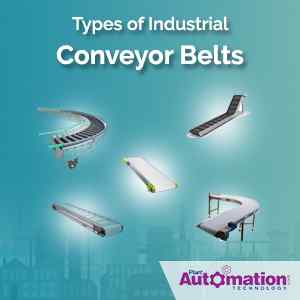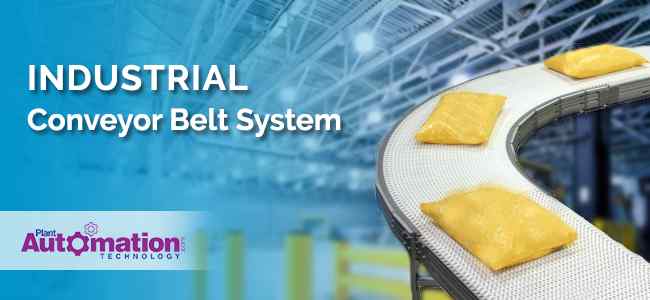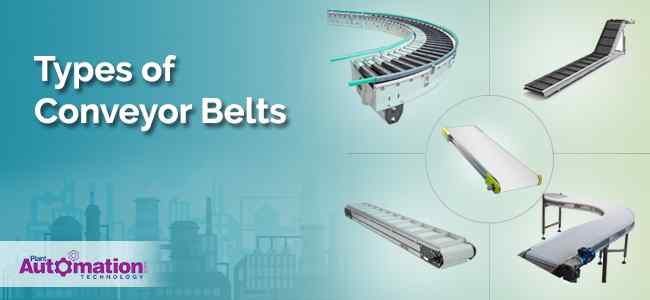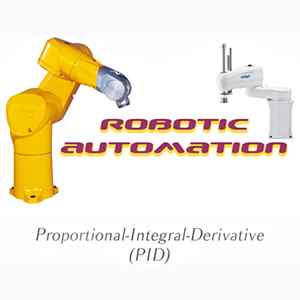Types of Conveyor Belts used for Industrial Purposes

Introduction:
A conveyor belt is an essential tool in the material handling sector. They are the continuous moving strips that are used for carrying different materials from one place to another. Mostly used for conveying a large volume of materials in a short span of time. A conveyor belt is also known as a belt conveyor.
Industrial Conveyor belt system
Industrial Conveyor belt system comprises of two or more pulleys. A continuous loop of transport stream the conveyor belt rotates about them. In order to move the belt and the material to transport one or both the pulleys should be power-driven.
These belts are generally made of rubber, PVC, Urethane, Neoprene, Nylon, Nitrile, Polyester, leather and others. The industrial conveyor belts are made up of multiple layers of material. Most of the material transporting belts comprise of two layers. The underneath layer is known as Carcass and it gives the linear strength and shape. The Carcass is made up of Polyester, nylon and cotton. The upper layer is known as the cover. Diverse variants of rubber or plastic compounds are utilised to make the cover.
| Also Read: A Comprehensive Guide to Choosing Conveyor Belt Materials for Industrial Automation |

Conveyor Belts that are used for Industrial Purposes:
Almost all of the manufacturers and suppliers were greatly dependent on the manpower before the emergence of industrial conveyor belts. The safety of the workforce and the quality of the product is a major issue under the manual handling of the products. In the current industry-driven scenario these rotating pulleys and belts are chosen for product handling.
Presently, a sophisticated technology is used in the Industrial Conveyor Belts over the simple belt conveyor systems. Advanced belts are opted based on their application by the industries. For instance, a simple metal belt would not be able to handle stones which could be precious or sensitive materials. Material handling Industries completely understand the types of conveyor belts. On the basis of their applications, they choose the safer, less time consuming, efficient belt conveyor systems as per their requirement.
| Also Read: Innovations in Industrial Conveyor Belt Technology: Enhancing Safety and Performance |
The most widely used Industrial Conveyor Belts and their applications:
- Solid, general-use belts:
These solid General use belts are commonly used in industries. They are made of rubber or a fabric such as nylon, polyester, neoprene, or nitrile. The primary applications of the belt can be determined by the properties of the belt. If we consider, mining and milling industries they commonly use rubber belts in handling the materials like raw ore and aggregates in a bulk quantity. Whereas, at the grocery stores, they make use of PVC conveyor belts and at the Airports belts made of Neoprene, polyester, or rubber are used for handling baggage.
- Filter belts:
In order, to drain out the excess liquid or toxins, Water treatment industries commonly use these Filter belts which permit the particles to pass through a filter instead of being carried by the conveyor system.
| Also Read: Efficiency in Motion: Conveyors & Conveying Equipment for Streamlined Operations |
- Woven metal belts:
These belts are mainly used in industries which deal with cooling, drying and heating processes in the sectors like food manufacturing, electronics and glass – manufacturing industries. These belts are made of interlinked chains or wiring to facilitate the flow of air while the product is carried.
- Hinged belts:
The Industries which handle scrap and various small products for recycling mainly make use of these hinged belts. These belts are made of metal. These belts provide a flat, solid surface which rotates around the pulley by means of the interlocking hinges. These belts are very sturdy and can be used rigorously.
- Plastic interlocking belts:
These are mainly used in food packaging industries and in the automotive sector. These belts are suitable for environments where there would be regular cleaning and belt change. These Plastic belts are the perfect substitute for fabric and metal belts.
Types of Conveyor Belts that are used in Industries:

The major types of conveyor belts that are used in industries are as follows:
- Flat Belt Conveyors
A number of powered pulleys are used to move the continuous flat belts made up of Synthetic and natural fabrics like polyester, nylon. These flat belt conveyors are the most commonly used and easily adaptable industrial conveyor systems.
- Modular Belt Conveyors
This type of conveyor belts comprise of individual and interlocked belting and are generally made of hard plastic.
- Cleated Belt Conveyors
Alongside the belt’s width, there are vertical cleats put together in these cleated Belt Conveyors.
- Curved Belt Conveyors
This type of conveyor belt carries materials around the corners of the floor making the best possible way to use up the available floor space with its unique curved frame feature.
- Incline or Decline Belt Conveyors
Incline or Decline Belt Conveyors are made used when the materials are needed to be conveyed at an angle of conveyance.
|
Also Read: Improving Supply Chain Efficiency: Conveyor Belt Manufacturers and Automation Solutions |
Importance of Conveyors in Industrial Automation
The conveyors in industrial automation have a wide range of purposes and use, ranging from the manufacturing sector to the packaging and supply.
Below are the main reasons which will enlighten the importance conveyors in industrial automation systems.
- Manual Waste Reduction
In a material handling industry, there would be specific tasks in a process which require transporting objects which are heavy in the line of production. In the course of accomplishing these tasks, there is a lot of manpower used and is wasted, adds no value to the production process. Moreover, there are possibilities of human injuries and loss of lives.
To obtain an increased production over a short time span, an automated conveyor system should be introduced in a material handling industry. This will make sure the manpower utilize their time on critical business development tasks rather than wasting on unproductive work.
| Also Read: Predictive Maintenance for Conveyor Belts: Reducing Downtime and Costs |
- Flexibility guaranteed
Never assume that conveyors are inflexible and are motionless, Modular conveyors are very much flexible and are used in several operations. On top of this, they are very much easy to install.
As flexibility is the key, try choosing a modular conveyor system so that you are allowed to customize your conveyor system for as per your requirement and serve you better.
You can still achieve flexibility by installing a fixed conveyor system by proper configuration and arrangement. Through this you can achieve flexibility by straight lines, this fixed conveyor system can transport materials from many production and storage locations to the final destination.
- Improved Quality Control
On the introduction of conveyors in industrial automation, one can eradicate the scrap and thus would result in improved quality control. In addition, it also helps in identifying the crucial problems related to the product like the faulty parts and unnecessary metal. Through an automated conveyor system, one can organize products for the upcoming operations.
Among numerous advanced technologies, conveyors are widely popular in implementing a manufacturing or production unit.











